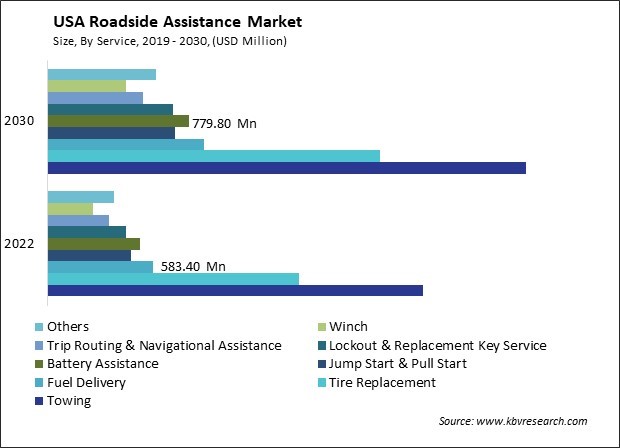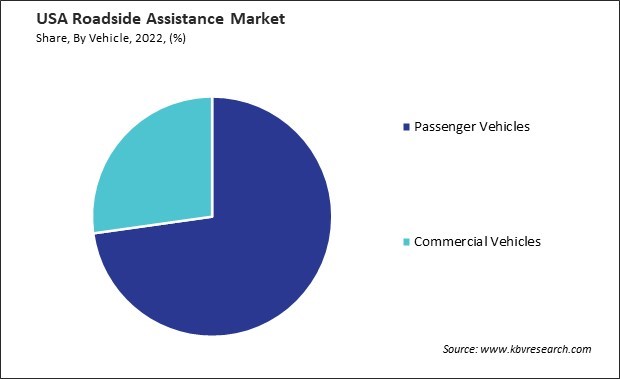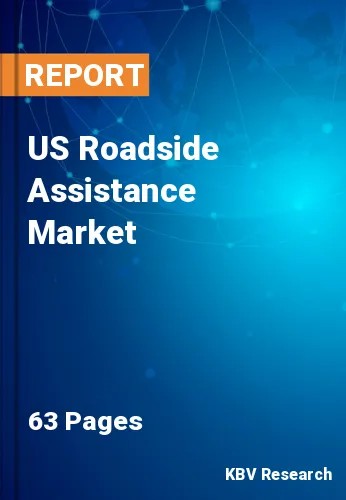The USA Roadside Assistance Market size is expected to reach $9.1 billion by 2030, rising at a market growth of 4.2% CAGR during the forecast period.
The roadside assistance market in the United States has experienced substantial growth and evolution, driven by various factors that reflect consumers' changing needs and preferences. One of the key drivers behind expanding the roadside assistance market in the U.S. is the increasing complexity and sophistication of modern vehicles. As automobiles become more technologically advanced, breakdowns or malfunctions often require specialized knowledge and equipment for repair. Roadside assistance services have adapted to this trend by providing traditional services like towing and tire changes and incorporating technical support for issues related to electronic systems and software.

Moreover, the rise of on-demand services and the sharing economy has contributed significantly to the growth of the roadside assistance market. With the popularity of ridesharing and car-sharing platforms, there is an increased need for prompt and reliable assistance in case of emergencies. This has led to innovative roadside assistance models that cater specifically to these new forms of mobility, offering tailored solutions for drivers participating in ridesharing services or utilizing shared vehicles.
The automotive industry plays a pivotal role in the thriving roadside assistance market in the United States, offering essential services to drivers facing unexpected vehicle breakdowns or emergencies. Roadside assistance has become an integral part of the automotive ecosystem, providing peace of mind to motorists and ensuring their safety on the nation's vast road networks. One of the primary drivers of the roadside assistance market in the U.S. is the sheer size and complexity of the country's road infrastructure. With millions of vehicles traversing the extensive network of highways and byways, the likelihood of breakdowns or accidents is substantial.
In the U.S., major automotive manufacturers and service providers have recognized the increasing demand for roadside assistance, prompting them to offer comprehensive programs beyond traditional warranties. These programs often include services such as towing, battery jump-starts, tire changes, fuel delivery, and lockout assistance. The competitive landscape has led automotive companies to differentiate themselves by enhancing the scope and efficiency of their roadside assistance offerings.
Additionally, technological advancements have played a pivotal role in reshaping the roadside assistance landscape. Many automotive companies leverage mobile apps and telematics to streamline the request process, providing users with real-time assistance updates and improving the overall customer experience. These technological enhancements enhance service delivery efficiency and contribute to a more seamless and user-friendly interaction between drivers and roadside assistance providers.
According to the Alliance for Automotive Innovation, in the United States, the automotive manufacturing sector plays a significant role, contributing 11% to the country's Gross Domestic Product (GDP). The overall manufacturing economy of the U.S., ranked as the eighth largest globally, generated $2.64 trillion in value added in 2021. Within this robust manufacturing landscape, the production of motor vehicles and related parts accounts for 6% of the total manufacturing output and constitutes 11% of the durable goods subsector.
As the automotive industry continues to thrive, a parallel trend is emerging with the increasing number of automotive companies offering roadside services. This growth in the provision of roadside assistance aligns with the broader economic impact of the automotive sector, further enhancing its influence on the U.S. economy. Thus, the success of the automotive industry and the flourishing roadside assistance market in the U.S. are interconnected, both playing pivotal roles in ensuring a smooth and secure driving experience for the nation's diverse fleet of vehicles.
In recent years, the roadside assistance market in the United States has witnessed a notable surge in the presence and prominence of insurance companies offering these services. Traditionally dominated by standalone roadside assistance providers and automobile clubs, this shift marks a significant evolution in the industry landscape. Insurance companies capitalize on their financial stability and vast networks to negotiate partnerships with towing companies, repair shops, and other service providers. This enables them to offer nationwide coverage, ensuring their customers receive timely assistance regardless of location.
The rise of insurance companies entering the roadside assistance market is attributed to several factors. The insurance companies recognize the value of diversification as they seek to expand their service offerings beyond traditional coverage plans. By incorporating roadside assistance into their portfolios, they enhance their product range and cater to the growing demand for comprehensive and all-encompassing coverage.
Moreover, insurance companies leverage their existing customer base and infrastructure to integrate roadside assistance services seamlessly. This approach allows them to cross-sell and bundle services, providing customers with a one-stop solution for their insurance and roadside assistance needs. This synergistic strategy enhances customer loyalty and fosters increased revenue streams for insurance companies.

The roadside assistance market in the United States is a crucial component of the automotive industry, providing services that range from towing to flat tire assistance. AAA (American Automobile Association) is among the roadside assistance industry's most well-known and established names. With a long history from 1902, AAA provides a wide range of automotive services, including emergency roadside assistance, towing, battery service, and flat tire assistance. The company is a federation of motor clubs throughout North America, serving millions of members.
As a subsidiary of Allstate insurance giant, Allstate Roadside Services leverages its parent company's resources to provide a wide range of roadside assistance solutions. Allstate's offerings often extend beyond traditional services, incorporating features such as trip interruption coverage and mobile app-based service requests.
Good Sam is a specialized provider of roadside assistance services for RVs and campers in the U.S. They offer towing, flat tire assistance, fuel delivery, and even coverage for travel interruptions. Good Sam is well-regarded among the recreational vehicle community for its comprehensive and tailored assistance programs.
Agero is a leading provider of roadside assistance and connected vehicle services. The company partners with automotive manufacturers, insurance companies, and fleet managers to deliver a range of roadside assistance solutions. Agero utilizes advanced technology to streamline the assistance process, ensuring timely and efficient support for drivers.
National General offers roadside assistance through its motor club. The company provides towing, flat tire assistance, lockout protection, and trip interruption coverage. National General's roadside assistance is available as an add-on to its auto insurance policies or as a standalone service.
Better World Club distinguishes itself by being an environmentally friendly alternative in the roadside assistance market. They offer towing, battery service, and flat tire assistance in the U.S. Additionally, they promote eco-friendly practices and provide discounts for hybrid and electric vehicle owners.
By Service
By Vehicle
By Provider
Our team of dedicated experts can provide you with attractive expansion opportunities for your business.

